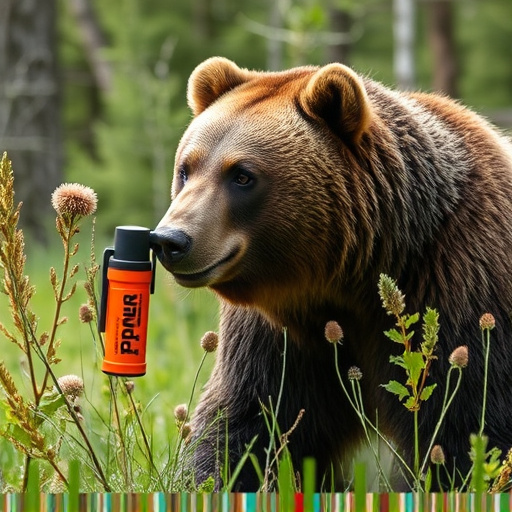Understanding bear behavior and adhering to TSA rules for bear spray (up to 6 oz in carry-on) are key to preventing attacks while hiking, camping, or traveling in bear country. Choose approved formulas with high capsaicin concentrations, consider range, mist pattern, and ease of use. Proper deployment aims at the bear's face and eyes to deter it, but awareness, noise-making, group travel, and secure food storage remain essential safety measures.
“In wild spaces, understanding potential threats is key to safety. One such formidable opponent is the bear, whose encounters can range from harmless to dangerous. This article equips readers with essential knowledge about outdoor safety during bear season. We explore ‘Tsa Rules for Bear Spray’, delving into bear behavior, TSA regulations, spray selection, and application techniques. By understanding these aspects, you’ll gain valuable tools to protect yourself in the wilderness, ensuring a safer adventure.”
- Understanding Bear Behavior: Knowing Your Potential Opponents
- TSA Rules and Regulations: What You Need to Know About Bear Spray
- Choosing the Right Bear Spray: Factors to Consider for Maximum Effectiveness
- Proper Usage and Application Techniques: Ensuring Safety in the Wild
Understanding Bear Behavior: Knowing Your Potential Opponents
Understanding bear behavior is a crucial step in preventing and managing potential encounters, especially when venturing into bear country. Bears are generally wary of humans and prefer to avoid conflict, but they can become aggressive if they feel threatened, surprised, or if their cubs are nearby. Knowing the types of bears in your region and their habits can help hikers, campers, and outdoor enthusiasts make informed decisions to stay safe. For example, black bears often defend themselves only when cornered or surprised, while grizzly bears (or brown bears) have a more aggressive reputation but typically attack only if provoked or protecting their food source.
When planning outdoor activities in areas where bears are present, adhering to TSA rules for bear spray is essential. Bear spray, an aerosolized pepper spray, can be an effective deterrent when used properly. It’s important to choose the right type of spray, understand how and when to deploy it, and practice using it regularly. By understanding your potential opponents’ behavior and following safety guidelines, you can significantly reduce the risk of a bear attack and enjoy your time outdoors with greater peace of mind.
TSA Rules and Regulations: What You Need to Know About Bear Spray
When packing for travel, especially outdoor adventures, it’s crucial to understand TSA rules for bear spray. The Transportation Security Administration (TSA) has specific guidelines regarding aerosol containers, including bear spray, to ensure safety during air travel. These regulations are in place to prevent any potential hazards and ensure the well-being of all passengers.
Bear spray is considered an acceptable item for carry-on luggage under certain conditions. The TSA allows passengers to bring aerosol cans that contain up to 6 ounces (170 grams) of bear spray. However, the can must be in its original packaging and clearly labeled as a bear spray. It’s important to note that any size larger than 6 ounces is restricted and should be packed in checked baggage. Always check the TSA website for the latest rules and regulations before packing your gear for your next outdoor trip.
Choosing the Right Bear Spray: Factors to Consider for Maximum Effectiveness
When selecting a bear attack prevention spray, several key factors come into play to ensure its effectiveness. First, understand that not all sprays are created equal; they vary in terms of active ingredients, spray patterns, and concentration. Check for approved formulas that meet guidelines like those set by the TSA (Transportation Security Administration). The spray should ideally contain a high percentage of capsaicin, the active ingredient responsible for the burning sensation that deters bears.
Second, consider the range and spray pattern. A good bear spray should have a range of at least 20 feet and provide a wide, even mist to cover your body and face. Ensure you can easily operate it with gloved hands, as you might need to use it in emergency situations. Additionally, familiarize yourself with local regulations regarding the carrying of bear spray, especially when traveling, as the TSA has specific rules for transporting such items on flights.
Proper Usage and Application Techniques: Ensuring Safety in the Wild
Proper usage and application techniques are crucial when it comes to bear attack prevention spray, as it can be a game-changer in potentially life-threatening situations. Understanding how and when to use this powerful tool is essential for ensuring safety while exploring the wilderness. Bear spray, when used correctly, creates a barrier that discourages bears from approaching by temporarily blinding and irritating their sense of smell. According to TSA rules for bear spray, users should aim for the bear’s face and eyes, creating a large enough mist to cover its entire body. This direct application is key to maximizing the spray’s effectiveness.
To guarantee safety in the wild, it’s important to remember that bear spray is not a substitute for awareness and prevention measures. Users should always make noise while hiking through bear country, travel in groups, and carry food securely. Knowing local bear behavior and staying alert can further enhance personal safety during outdoor adventures.
In conclusion, understanding bear behavior, familiarizing yourself with TSA rules on bear spray, selecting the appropriate product, and mastering application techniques are key components of outdoor safety. By adhering to these guidelines, you can better protect yourself in potential encounters, ensuring a more enjoyable and secure experience in nature. Remember, knowledge is your best defense when navigating wild territories.
